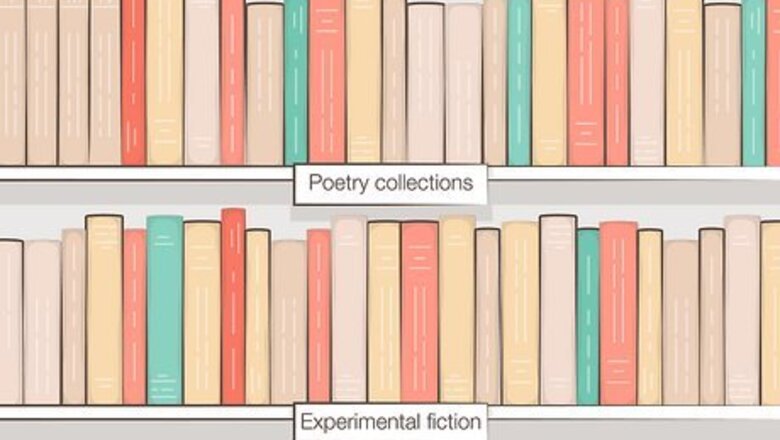
views
Organize your books by genre.
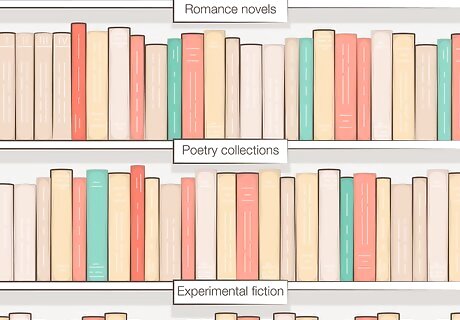
Separating books by genre will make it easier for you to find books fast. You might have one shelf for romance novels, another for poetry collections, and a third for experimental fiction. By separating your shelves by genre, you’ll build a mental map of where everything belongs. You also won’t need to worry about putting books back in the perfect slot, since a book that belongs on a given shelf can go anywhere on that shelf. This is a particularly good solution if you tend to go through phases in your reading where you get super into historical fiction one month, then move on to nonfiction science books another month, and so on. This may not be the best choice if a majority of your books fit into one genre. If you have 6 shelves worth of literary theory but only a handful of Greek plays, there won’t be a ton of variation from shelf to shelf.
Sort them alphabetically.
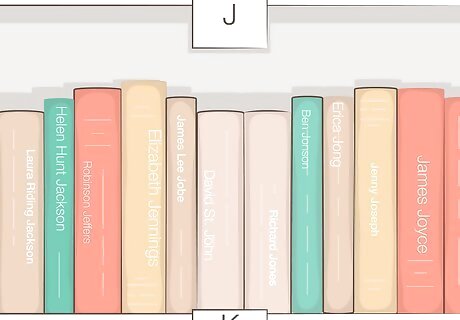
Sorting by the author’s last name is a classic way to organize. If you have an especially large collection, sorting by author will make it a lot easier to locate a given book when you want it. Looking for a book written by James Joyce? Just find the “J” section! It doesn’t get much easier than that. If you struggle remembering names, this isn’t going to be an ideal solution. You’re probably going to end up spending more time digging than you’d like when it’s time to grab a certain book. This may not be the best choice for you if the idea of Raymond Chandler mystery stories sitting on a shelf next to Noam Chomsky’s political theory strikes you as a strange combination.
Arrange your books by color.
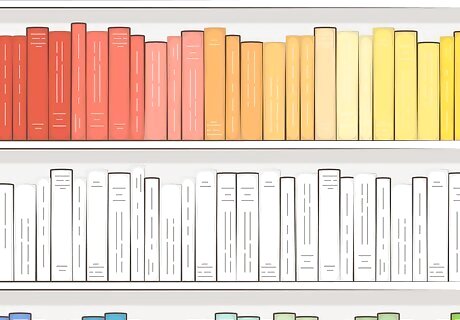
For a visually-striking look, organize your books by color! You could put all of your white books on one shelf, red books on another, followed by yellow, and so on. Alternatively, you could go for a “spectrum” look where your red books bleed into orange, yellow, green, blue, and black. This can make for a stunning display, and guests are sure to be impressed when they see your library! This is also a super good idea if you have a great visual memory and you don’t have a lot of trouble remembering what book covers look like. While the rainbow-style of color organization is undoubtedly the most popular, you can absolutely play around with it. You could put patches of white books around your shelves, throw in some vertical stacks of red books, and throw some randomized rows in there. If you don’t have a very diverse collection cover-wise, or you’ve got a bunch of books with multicolored jackets, this may be a tough way to organize since your collection may look imbalanced or disorganized.
Organize them by subject.
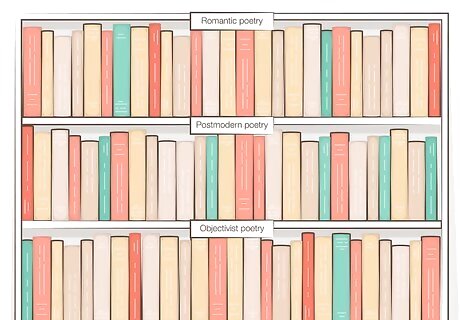
For a narrower collection, arranging the books by subject makes sense. If you’re a huge poetry buff, you could separate your Romantic collections, postmodern books, and objectivist poetry. If you’re super into historical nonfiction, give World War 1 its own shelf, the Civil Rights Movement another shelf, and books about the United Nations in another area. This is an especially good way to sort your collection if you have a massive interest in one particular type of literature, since you can break your organization down ever further as your library grows. Someone who reads a lot of scientific nonfiction might break it down further into books about genetics, books about hormones, and so on.
Sort your books chronologically.
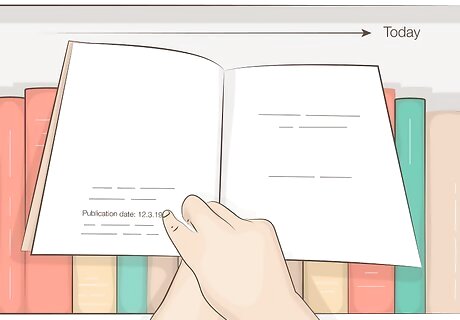
Sorting by publication date is a cool way to present a collection. People don’t do this very often, but it may be neat to see history visualized on your bookshelves. You can start with the classics and work your way forward to keep the older books at the top of your shelves, or work from the present back so that your most modern books are the most visible. This is an especially interesting way to arrange your books if you’re a huge fan of history, or you own a lot of historical nonfiction. If your collection contains a ton of books from one period of history—like most of the books you own were printed after 1950, for example—this will be kind of tricky. You can do it, but you may need to reference the inside of each book’s jacket to double-check the publication date, and this may not feel particularly intuitive.
Put rare or valuable books in a noticeable spot.
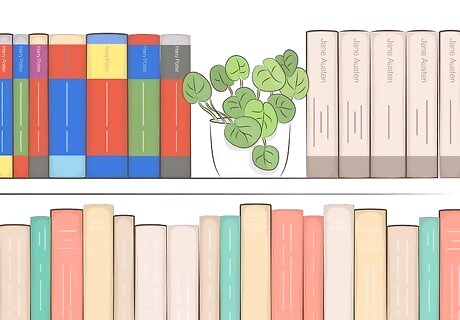
If you have any rare or unique books, put them at eye level. This way, when guests are perusing the titles sitting on your shelves, they’ll see the most interesting books you own immediately. Organize the rest of your books from most interesting to least interesting, with the dullest books in your collection sitting at the bottom. This should also make it quite easy to remember where specific books are, since you’ll have an intuitive sense for where you would have put each text. If you just can’t find a way to sort your books where your most interesting titles are the most visible, this is a great way to do it. You can even place a few plants or knick-knacks on your top shelves to separate unique mini-collections you own and want to highlight. You might have the first edition of each Harry Potter book up top, leaning against a plant, followed by a stack of Jane Austen novels from the early 1900s. By separating your books, they’ll stand out even more on the shelves.
Organize your books by how much you like them.
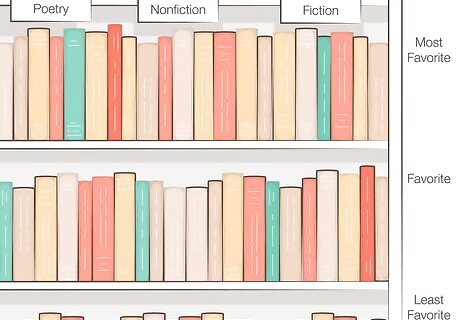
Put your favorites up top and your least favorites at the bottom. This is going to be totally subjective, but it may be fun to spend an evening taking the books down and appraising how you feel about it. Did a book radically change your life? Top shelf it goes! Do you only hold on to that dusty old etymological dictionary for reference purposes? Keep it on the bottom shelf. If you have a really large collection of books, this may make it hard to keep track of where things are. However, you could combine this with a genre or subject style of organization to make it easier. For example, you could stack all of your poetry on the left side of every shelf, with your favorites on top, followed by nonfiction in the middle of each shelf, and fiction on the right side. EXPERT TIP Kathi Burns, CPO® Kathi Burns, CPO® Board Certified Professional Organizer Kathi Burns is a board certified Professional Organizer (CPO) and Founder of Organized and Energized!, her consulting business with a mission to empower people to master their environment and personal image by assisting them in taking control, making change and organizing their lives. Kathi has over 17 years of organizing experience and her work has been featured on Better Homes and Gardens, NBC News, Good Morning America, and Entrepreneur. She has a BS in Communication from Ohio University. Kathi Burns, CPO® Kathi Burns, CPO® Board Certified Professional Organizer If there are old books you don't want or need anymore, keep a donation bin in your house in a closet. Anytime you find a book that you don't want, go throw it in that bin. When it gets full, take it to a charity. You should always make sure to have an immediate exit strategy for your excess books!
Display the books you use the most.
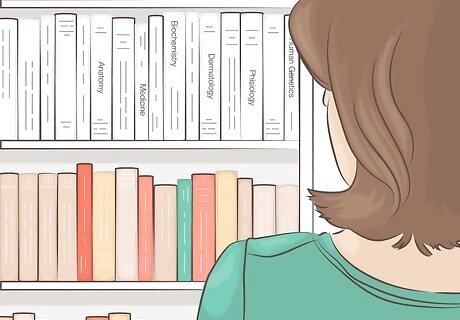
Put the books you use most often at eye level to grab them fast. Reserve the bottom shelf for books that you’re extremely unlikely to revisit in the future. This is an especially good idea if you don’t have a huge collection, since it won’t take you very long to scan each shelf for the book you’re looking for. This is especially smart if you have a bunch of reference books because you’re in medical or law school.
Sort them by size.
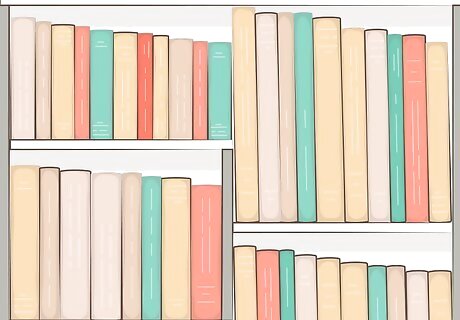
For modular or asymmetrical shelves, you can sort by size for a unique take. Put all of your largest books on the shelf with the most vertical space. Place all of your smallest books together on the smaller shelves. Your collection will have an elegant Feng Shui where your shelves feel balanced and cleanly arranged. You could also arrange them by height from left to right. Put your tallest books on the left side of each shelf and work your way down to the smallest books. This will create an interesting cascading effect on each of your shelves. You can still do this if your shelves aren’t modular or asymmetrical. Use a combination of vertical stacks of book and horizontal rows to group books of nearly-identical sizes together. This will have a unique aesthetic effect where your shelves look simultaneously uniform and varied.
Organize your books by the date you got them.
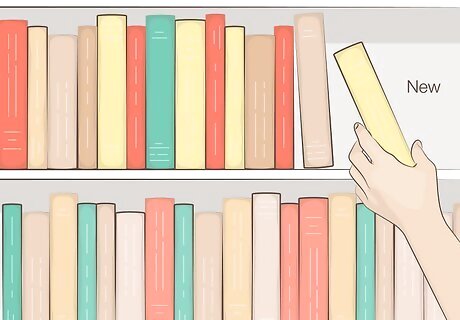
Do you forget to read all of the books you buy? Try this! Put your favorite childhood books all the way on the bottom right and start working your way up. At the top left of the shelving, place your newest purchases. This is the perfect solution if you buy a bunch of books at once and then forget to read them, since you’ll always have that “to read soon” section sitting at the top left! Over time, you will eventually fill your shelves out with books arranged in the order you read them. How cool is that? You’ll have this little visual record of your reading habits over the years!












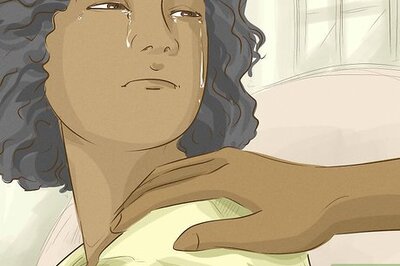




Comments
0 comment